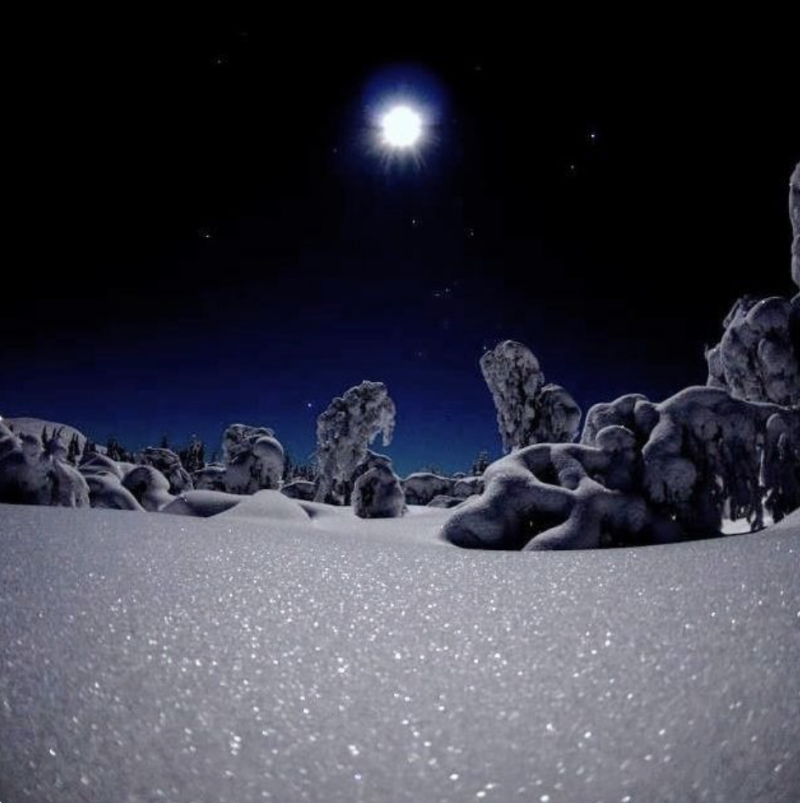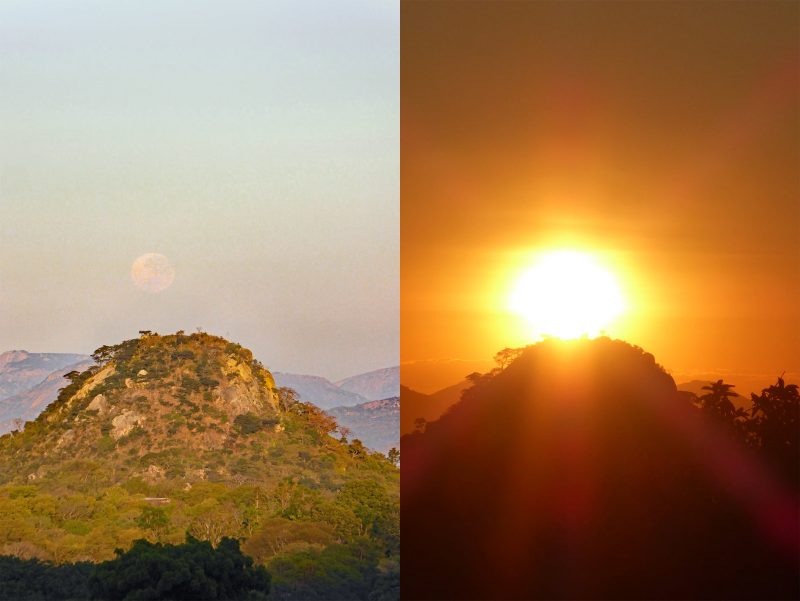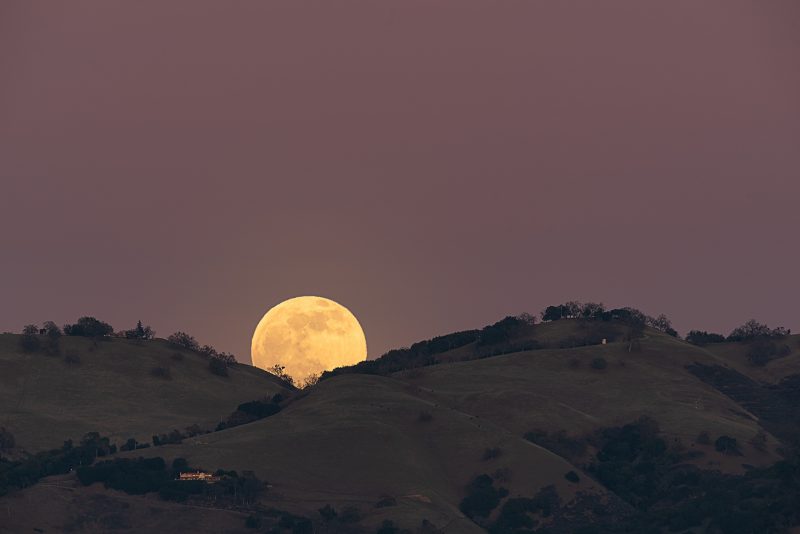
When is the December full moon?
Coming up this weekend, it’s the December full moon! In North America, we call this full moon by one of several nicknames: the Full Cold Moon, Moon Before Yule, or the Long Night Moon. Whichever name you use, the moon will cross high overhead in the Northern Hemisphere’s sky (while making a low arc from the Southern Hemisphere). For all of us, it’ll light up these chilly nights. Our nearest neighbor will appear to be full throughout this weekend. But the exact moment it’s full is 4:35 UTC on December 19 (10:35 p.m. CST on December 18). That’s the moment when the moon is directly opposite the sun as seen from Earth. It’s when we see the entire, fully illuminated day side of the moon.
This is the last full moon of the Northern Hemisphere’s autumn – and Southern Hemisphere’s springtime – and it’s also the last full moon of 2021.
Plus it’s also the closest full moon to the December solstice. The solstice, which marks the start of winter in the Northern Hemisphere (summer in the Southern Hemisphere), falls on December 21.
This full moon happens one day after it reaches the farthest point in its orbit around Earth, called apogee. At apogee in December, the moon is 252,000 miles (400,000 km) away. That’s about 12,000 miles (19,000 km) more than the average moon-distance from Earth. As a result, on the night of full moon – December 18-19, 2021 – the moon is measurably smaller in our sky than usual. Your eye probably won’t notice any difference, although the moon may appear less bright than you remember it at other months this past year. Many skywatchers are familiar with the term supermoon. That’s a particularly large and bright full moon, near perigee, or its closest point to Earth. December’s full moon is the opposite of a supermoon. We might call it a mini-moon or micromoon.
And here’s something you can watch for with the December full moon. From the Northern Hemisphere, the moon’s journey these next few nights will resemble the high path of the summer solstice sun.
The 2022 lunar calendars are here. Order yours before they’re gone!
December full moon mimics the June sun
Every full moon stays more or less opposite the sun. And the full moon’s path through the night is also opposite the sun’s path through the day. In fact, the moon’s path roughly follows the sun’s daytime path from six months ago, or six months from now. You can see this happening as you watch the December full moon rise to nearly the top of the sky, just as the sun does near the June solstice.
It does, that is, for those of us in the Northern Hemisphere. For the Southern Hemisphere, it’s the same effect. But, since it’s nearly summer there, the December full moon will ride low, as the December sun rides high.
Here’s another way to look at it. In the Northern Hemisphere, the December solstice has the least amount of daylight of the year. Since there’s still about 24 hours in a day no matter how much daylight there is, the shortest day means it must also be the longest night. In order for the moon to stay up all night and remain roughly opposite the sun, it needs to take a longer path across the sky. The higher an object crosses the sky, the longer its path and the longer it stays above the horizon.
Do you see why tonight’s moon is sometimes called the Long Night Moon?

Tracing the high path of the December full moon
You can experiment with the path of the sun and moon. Simply trace a line with your finger from east to west along the southern horizon to emulate the sun’s path. Then trace another path high overhead to emulate the moon’s path. You’ll see that the higher path will be much longer than the lower one.
Little by little, we can watch the two paths come back into balance. Each month, the full moon will cross the sky at a slightly lower path than the previous month. Each successive full moon will take less time than the previous one to cross the sky.
At March’s full moon, which is near the Northern Hemisphere’s spring equinox, the two paths – of the moon and of the sun – will be nearly the same. Then, near the June solstice, those of us in the Northern Hemisphere will see the sun cross high overhead during the year’s longest days. And, during the short northern summer nights, we’ll see the moon cross lower and spend less time in the sky.
And on the cycle goes.
Rising and setting full moon
By the way, half of the moon is always lighted by the sun. The moon has a day side and a night side, just as Earth does. Full moon happens when the moon is directly opposite the sun from our earthly point of view.
Since it’s opposite the sun, every full moon rises and sets opposite the sun. And so every full moon rises in the east around sunset. From there, it climbs to its highest and southernmost point for the night around local midnight. This is halfway between your local sunset and sunrise. Then, it continues downward toward the horizon until it sets in the west around sunrise. So a moon that’s in the sky all night long is a full moon, or close to it.
Strictly speaking, we say the moon is full when it lies opposite the sun in ecliptic longitude (the moon-sun elongation = 180 degrees). Here’s that exact moment of full moon again: December 19, 2021, at 04:35 UTC (December 18, 10:35 p.m. Central Standard Time). When you see the moon before that moment – even just minutes before – it’s a waxing gibbous moon. When you see the moon after that moment – even just minutes after – it’s a waning gibbous.
Enjoy December’s full moon!

Bottom line: The 2021 December full moon happens on December 19 at 04:35 UTC (December 18, 10:35 p.m. Central Standard Time). That’s just two days before the December solstice. It closely follows the path of the June sun.
The post December full moon – a solstice full moon – on December 18-19 first appeared on EarthSky.
from EarthSky https://ift.tt/3E4991I

When is the December full moon?
Coming up this weekend, it’s the December full moon! In North America, we call this full moon by one of several nicknames: the Full Cold Moon, Moon Before Yule, or the Long Night Moon. Whichever name you use, the moon will cross high overhead in the Northern Hemisphere’s sky (while making a low arc from the Southern Hemisphere). For all of us, it’ll light up these chilly nights. Our nearest neighbor will appear to be full throughout this weekend. But the exact moment it’s full is 4:35 UTC on December 19 (10:35 p.m. CST on December 18). That’s the moment when the moon is directly opposite the sun as seen from Earth. It’s when we see the entire, fully illuminated day side of the moon.
This is the last full moon of the Northern Hemisphere’s autumn – and Southern Hemisphere’s springtime – and it’s also the last full moon of 2021.
Plus it’s also the closest full moon to the December solstice. The solstice, which marks the start of winter in the Northern Hemisphere (summer in the Southern Hemisphere), falls on December 21.
This full moon happens one day after it reaches the farthest point in its orbit around Earth, called apogee. At apogee in December, the moon is 252,000 miles (400,000 km) away. That’s about 12,000 miles (19,000 km) more than the average moon-distance from Earth. As a result, on the night of full moon – December 18-19, 2021 – the moon is measurably smaller in our sky than usual. Your eye probably won’t notice any difference, although the moon may appear less bright than you remember it at other months this past year. Many skywatchers are familiar with the term supermoon. That’s a particularly large and bright full moon, near perigee, or its closest point to Earth. December’s full moon is the opposite of a supermoon. We might call it a mini-moon or micromoon.
And here’s something you can watch for with the December full moon. From the Northern Hemisphere, the moon’s journey these next few nights will resemble the high path of the summer solstice sun.
The 2022 lunar calendars are here. Order yours before they’re gone!
December full moon mimics the June sun
Every full moon stays more or less opposite the sun. And the full moon’s path through the night is also opposite the sun’s path through the day. In fact, the moon’s path roughly follows the sun’s daytime path from six months ago, or six months from now. You can see this happening as you watch the December full moon rise to nearly the top of the sky, just as the sun does near the June solstice.
It does, that is, for those of us in the Northern Hemisphere. For the Southern Hemisphere, it’s the same effect. But, since it’s nearly summer there, the December full moon will ride low, as the December sun rides high.
Here’s another way to look at it. In the Northern Hemisphere, the December solstice has the least amount of daylight of the year. Since there’s still about 24 hours in a day no matter how much daylight there is, the shortest day means it must also be the longest night. In order for the moon to stay up all night and remain roughly opposite the sun, it needs to take a longer path across the sky. The higher an object crosses the sky, the longer its path and the longer it stays above the horizon.
Do you see why tonight’s moon is sometimes called the Long Night Moon?

Tracing the high path of the December full moon
You can experiment with the path of the sun and moon. Simply trace a line with your finger from east to west along the southern horizon to emulate the sun’s path. Then trace another path high overhead to emulate the moon’s path. You’ll see that the higher path will be much longer than the lower one.
Little by little, we can watch the two paths come back into balance. Each month, the full moon will cross the sky at a slightly lower path than the previous month. Each successive full moon will take less time than the previous one to cross the sky.
At March’s full moon, which is near the Northern Hemisphere’s spring equinox, the two paths – of the moon and of the sun – will be nearly the same. Then, near the June solstice, those of us in the Northern Hemisphere will see the sun cross high overhead during the year’s longest days. And, during the short northern summer nights, we’ll see the moon cross lower and spend less time in the sky.
And on the cycle goes.
Rising and setting full moon
By the way, half of the moon is always lighted by the sun. The moon has a day side and a night side, just as Earth does. Full moon happens when the moon is directly opposite the sun from our earthly point of view.
Since it’s opposite the sun, every full moon rises and sets opposite the sun. And so every full moon rises in the east around sunset. From there, it climbs to its highest and southernmost point for the night around local midnight. This is halfway between your local sunset and sunrise. Then, it continues downward toward the horizon until it sets in the west around sunrise. So a moon that’s in the sky all night long is a full moon, or close to it.
Strictly speaking, we say the moon is full when it lies opposite the sun in ecliptic longitude (the moon-sun elongation = 180 degrees). Here’s that exact moment of full moon again: December 19, 2021, at 04:35 UTC (December 18, 10:35 p.m. Central Standard Time). When you see the moon before that moment – even just minutes before – it’s a waxing gibbous moon. When you see the moon after that moment – even just minutes after – it’s a waning gibbous.
Enjoy December’s full moon!

Bottom line: The 2021 December full moon happens on December 19 at 04:35 UTC (December 18, 10:35 p.m. Central Standard Time). That’s just two days before the December solstice. It closely follows the path of the June sun.
The post December full moon – a solstice full moon – on December 18-19 first appeared on EarthSky.
from EarthSky https://ift.tt/3E4991I

Aucun commentaire:
Enregistrer un commentaire